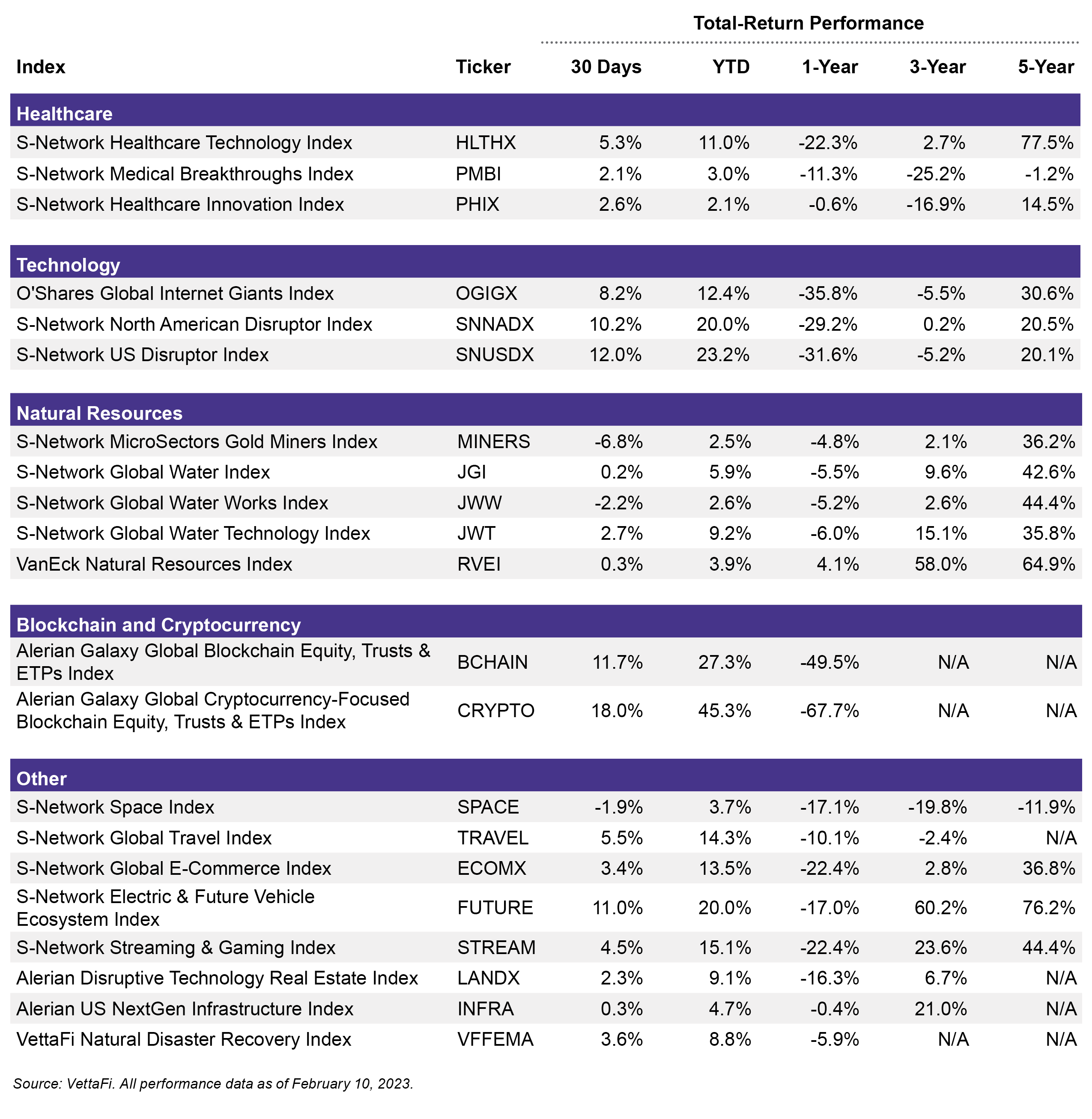Last week at Exchange: An ETF Experience, I hosted a panel called “Thematics—Separating Hype From Opportunity.” The panel featured Laura Morrison, Chief Revenue Officer at Direxion and Ryan O. Issakainen, ETF Strategist at First Trust. Additionally, I spent four days at the Fontainebleau having meetings, spontaneous conversations, and attending sessions. These are some of the takeaways regarding thematics (and more):
The active vs. passive debate extends to thematic ETFs. While I focus mostly on index-based strategies in my research, active ETFs were widely discussed at the conference—so I had to ask my panelists about the active vs. passive debate from a thematic perspective. Passive, index-based ETFs offer simplicity (including transparency and lower fees) which can be valuable when dealing with complex strategies. But active strategies have the advantage of being flexible in volatile markets. This is especially true for thematic strategies with limited pure-play constituents. An active strategy may allow the fund to invest in a broader range of constituents and incorporate a theme into a more diversified strategy, which may be able to act more defensively or aggressively depending on the current market environment.
ETF investors often embrace creativity. I started the weekend at Exchange thinking that thematic ETFs would be an outlier in conversations, but many attendees were still willing to discuss thematics. The most popular thematic topic seemed to be anything related to clean energy, alternative energy, or electric vehicles. As I suspected, these sort of thematic strategies tend to be more popular as they are not only driven by disruptive technology and consumer preference but also supported by changing global regulations. But a lot of attendees were representing ETFs that weren’t necessarily thematic but fit into the definition of creative and groundbreaking. These included ETFs like the Hypatia Women CEO ETF (WCEO) and the Reverb ETF (RVRB). WCEO is the first ETF to invest in only companies led by female CEOs based on the thesis that women have to break more barriers to earn a CEO role and therefore these companies may be able to generate more return. RVRB weights its holdings based on ratings collected via its proprietary Reverberate App where the public is invited to express its views on each constituent.
Less chatter on crypto and blockchain ETFs. While I discussed above how ETF investors are embracing creativity, I think most attendees at Exchange agreed that overall, there was still a return to normalcy. At previous ETF conferences, crypto and ESG topics dominated the agenda. But this year, I didn’t see any sessions strictly focused on either of those topics. I even told myself I wouldn’t ask my panelists about crypto but we received a question from the audience on crypto and its relation to thematic investing. While crypto ETFs (futures-based Bitcoin ETFs and potential spot-based Bitcoin ETFs) aren’t directly related to thematic investing, blockchain and crypto economy ETFs are considered thematic ETFs. I think blockchain and crypto economy ETFs are a good example of a thematic strategy that saw a large pull-forward over the last couple of years and then suffered from being over-hyped. Now that we are seeing investors become more rational and Bitcoin prices level off, I think blockchain ETFs still have the potential to be used as a high risk/high reward investment as a portion of a larger tech allocation.
Artificial intelligence has never seemed more real. Years ago, when I was starting out as an equity research associate, we thought robo-advisors could potentially replace research analysts. This obviously didn’t happen but now with technology like ChatGPT we could potentially see multiple industries reinvented. The issue from an investing perspective is that there are very few public companies to make this concept investable. It is more likely, however, that AI will permeate thematic ETFs indirectly. For example, AI technology could improve autonomous vehicles (Chinese EV company Jidu is already considering using Baidu’s ChatGPT-like product). We could also see more advanced AI in biotechnology which could potentially help fill gaps in medical knowledge and diagnoses.
Eggs are expensive. Inflation was high across the board in 2022, but out of food items and basic necessities, eggs saw the highest inflation with prices up 59.9% year-over-year. January CPI figures were released earlier this week and while inflation has shown some sign of moderation, eggs were once again the highest food category—up 70.1% y/y. Why is this so important? Eggs are one of the most essential food items that people buy for breakfast, baking, and other meals. While much of the inflation in egg prices can be attributed to lower egg production from the avian flu, there are also higher costs related to transportation costs and higher grain feed prices which are passed through to egg prices. So while it is easy to make jokes and puns about expensive eggs, I think it actually supports a very important point. If the consumer (which accounts for over 2/3 of U.S. GDP) cannot first afford basic food items like eggs, disruptive technology like artificial intelligence or autonomous vehicles do not seem as compelling—both from a consumer and an investor perspective. Once inflation moderates, I think retail investors will also be less risk averse relative to thematic strategies. Fortunately, thematic indexes have already seen positive performance YTD with most VettaFi indexes up in the double-digit range; however, I believe inflation (including the high cost of eggs) remains one of the largest roadblocks in the near-term.
Associated thematic indexes and ETFS:
The Alerian US NextGen Infrastructure Index (INFRA) is the underlying index for the First Trust Alerian US NextGen Infrastructure ETF (RBLD).
The S-Network Global E-Commerce Index (ECOMX) is the underlying index for the First Trust S-Network E-Commerce ETF (ISHP).
The S-Network Global Travel Index (TRAVEL) is the underlying index for the ALPS Global Travel Beneficiaries ETF (JRNY).
The S-Network Space Index (SPACE) is the underlying index for the Procure Space ETF (UFO) and the Procure Space UCITS ETF (YODA).
The S-Network Streaming & Gaming Index (STREAM) is the underlying index for the First Trust S-Network Streaming & Gaming ETF (BNGE).
The S-Network Electric & Future Vehicle Ecosystem Index (FUTURE) is the underlying index for the First Trust S-Network Future Vehicles & Technology ETF (CARZ).
The Alerian Galaxy Global Blockchain Equity, Trusts & ETPs Index (BCHAIN) is the underlying index for the Invesco Alerian Galaxy Blockchain Users and Decentralized Commerce ETF (BLKC).
The Alerian Galaxy Global Cryptocurrency-Focused Blockchain Equity, Trusts & ETPs Index (CRYPTO) is the underlying index for the Invesco Alerian Galaxy Crypto Economy ETF (SATO).


